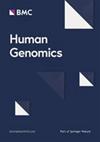伊朗早发遗传性共济失调的遗传基础:全国异质人群登记结果
IF 3.8
3区 医学
Q2 GENETICS & HEREDITY
引用次数: 0
摘要
为了研究伊朗早发进行性小脑共济失调症的遗传学,我们在该国儿科疾病的主要转诊中心--儿童医学中心(CMC)开展了一项研究,研究时间为 2019 年至 2022 年,为期三年。在本报告中,我们提供了国家登记处的初步调查结果。我们选择了所有具有常染色体隐性遗传模式的早发性患者,对他们的表型、辅助临床检查和基因型进行评估。临床数据包括临床特征、共济失调评估和评级量表(SARA)评分、磁共振成像(MRI)结果、电诊断检查(EDX)和生物标记特征。我们的基因检测包括单基因检测、全外显子组测序(WES)和全基因组测序(WGS)。我们的研究招募了来自我国不同地区的 162 名患者。在我们的亚群中,我们在 97 个家庭的 42 个基因中发现了已知和新的致病变体。总体基因诊断率为 59.9%。值得注意的是,我们分别在 19、14、12 和 10 个家庭中观察到了 PLA2G6、ATM、SACS 和 SCA 变异。值得注意的是,超过 59% 的病例归因于这些基因的致病变异。伊朗地处中东地区的十字路口,常染色体隐性遗传性共济失调的遗传病因极为多样。鉴于这种异质性,制定预防策略和有针对性的分子疗法变得至关重要。为这些疾病患者的诊断和管理制定国家指南,将大大有助于推进医疗保健方法和改善患者预后。本文章由计算机程序翻译,如有差异,请以英文原文为准。
The genetic basis of early-onset hereditary ataxia in Iran: results of a national registry of a heterogeneous population
To investigate the genetics of early-onset progressive cerebellar ataxia in Iran, we conducted a study at the Children’s Medical Center (CMC), the primary referral center for pediatric disorders in the country, over a three-year period from 2019 to 2022. In this report, we provide the initial findings from the national registry. We selected all early-onset patients with an autosomal recessive mode of inheritance to assess their phenotype, paraclinical tests, and genotypes. The clinical data encompassed clinical features, the Scale for the Assessment and Rating of Ataxia (SARA) scores, Magnetic Resonance Imaging (MRI) results, Electrodiagnostic exams (EDX), and biomarker features. Our genetic investigations included single-gene testing, Whole Exome Sequencing (WES), and Whole Genome Sequencing (WGS). Our study enrolled 162 patients from various geographic regions of our country. Among our subpopulations, we identified known and novel pathogenic variants in 42 genes in 97 families. The overall genetic diagnostic rate was 59.9%. Notably, we observed PLA2G6, ATM, SACS, and SCA variants in 19, 14, 12, and 10 families, respectively. Remarkably, more than 59% of the cases were attributed to pathogenic variants in these genes. Iran, being at the crossroad of the Middle East, exhibits a highly diverse genetic etiology for autosomal recessive hereditary ataxia. In light of this heterogeneity, the development of preventive strategies and targeted molecular therapeutics becomes crucial. A national guideline for the diagnosis and management of patients with these conditions could significantly aid in advancing healthcare approaches and improving patient outcomes.
求助全文
通过发布文献求助,成功后即可免费获取论文全文。
去求助
来源期刊

Human Genomics
GENETICS & HEREDITY-
CiteScore
6.00
自引率
2.20%
发文量
55
审稿时长
11 weeks
期刊介绍:
Human Genomics is a peer-reviewed, open access, online journal that focuses on the application of genomic analysis in all aspects of human health and disease, as well as genomic analysis of drug efficacy and safety, and comparative genomics.
Topics covered by the journal include, but are not limited to: pharmacogenomics, genome-wide association studies, genome-wide sequencing, exome sequencing, next-generation deep-sequencing, functional genomics, epigenomics, translational genomics, expression profiling, proteomics, bioinformatics, animal models, statistical genetics, genetic epidemiology, human population genetics and comparative genomics.
 求助内容:
求助内容: 应助结果提醒方式:
应助结果提醒方式:


